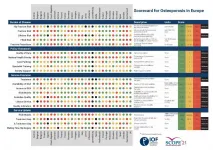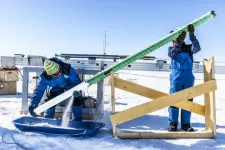Professor John A. Kanis, IOF Honorary President and lead author of SCOPE, stated:
"Osteoporosis is a major concern in Europe as it results in 4.3 million fragility fractures and health care costs in excess of €56 billion annually. Seeking to prioritize osteoporosis prevention in the EU27+2 countries, the SCOPE 2021 report has tracked key indicators of burden and service uptake which will help Europeans measure how well their country is able to provide quality care, including access to risk assessment and medications. It also provides a new benchmark to follow trends in osteoporosis management, and to measure future progress."
Osteoporosis is a progressive chronic disease that causes bones to become fragile and weak, leaving individuals at high risk of fragility fractures. Such fractures can have a serious impact on the sufferer, leading to pain, long-term disability and even premature death. In the EU27+2, there were estimated to be more than a quarter of a million fragility fracture-related deaths in 2019. This number is comparable to, or exceeds, other common causes of death such as lung cancer, diabetes, or chronic lower respiratory diseases.
Osteoporosis and fragility fractures place a heavy burden on Europe's population
SCOPE 2021 examined the burden of osteoporosis and fragility fractures in the EU27+2 countries, finding:
The total direct cost of fragility fractures was immense at €56.9 billion in 2019. This comprises €36.3 billion for direct costs of incident fractures, €19.0 billion for ongoing long-term disability costs (from fractures that occurred before 2019), and €1.6 billion for assessment and pharmacological treatment.
The average direct cost of osteoporotic fractures was €109.1 for each individual - in comparison, in 2010 the average for the EU27 was €85 (after adjusting for inflation).
Based on the WHO / bone mineral density criteria, there were approximately 32.0 million individuals with osteoporosis, of which 6.5 million were men and 25.5 million were women (2019).
An estimated 4.3 million new fragility fractures occurred in 2019--equivalent to 11,705 fractures/day (or 487 per hour).
Based on ten-year probability of a major fracture, 23.8 million Europeans had a probability of major fracture above the thresholds for high risk.
There was a marked difference in fracture risk among the countries. The probability of future hip fracture in men and women at the age of 50 years varied from 3.8-10.9% in men and 7.0-25.1% in women.
Given the projected increase in the aged population, the annual number of osteoporotic fractures in the EU27+2 is projected to rise by +24.8%; from 4.28 million in 2019 to 5.34 million in 2034.
Service provision lags in many countries
SCOPE 2021 also found notable inadequacies in service provision that hinder many Europeans from getting the care they need to prevent osteoporosis and fragility fractures:
In many countries there is suboptimal availability of DXA scanners, which are used to diagnose and monitor osteoporosis. Ten countries reported having less than the estimated minimum DXA units required, and only 15 of the 29 countries provide full reimbursement.
A wide variety of approved medications is available for the management of osteoporosis. Less than half of the countries offered full reimbursement for these medications.
Post-Fracture Care Coordination Programs (or Fracture Liaison Services) in hospitals were lacking in eight countries. Based on expert opinion, approximately half of the remaining countries reported that less than 10% of hospitals had such vital programs in place.
Large treatment gap indicates need for strategies to improve service uptake
Among the most startling findings of SCOPE 2021 is the enormous 'treatment gap' which is leaving the most high risk individuals unprotected against fragility fractures. Other measures of service uptake were also found to be suboptimal:
In 2019 an average of 71% of women at high fracture risk did not receive therapy for osteoporosis, ranging from 32% (Ireland) to 87% (Bulgaria).
In 2010 the gap was estimated at 55% (or 10.6 million women) who were eligible for treatment but were untreated - this number has risen to 14.8 million in 2019.
FRAX, the most commonly used risk assessment tool, is available for 24 of the 29 countries. However, its web-based usage varied widely from 49 to 41,874 sessions per million population. This indicates that the tool is underutilized in most countries.
Waiting times between admission to hospital and surgical intervention were on average greater than 48 hours in five of the 29 countries. Early surgery within 48 hours of a hip fracture has been shown to significantly reduce mortality and increase the proportion of patients returning to their original residence.
Professor Cyrus Cooper, President of IOF, welcomed the publication of SCOPE 2021 and urged European health authorities to prioritize osteoporosis and fracture prevention:
"This important publication clearly shows that osteoporosis is a major health care burden in Europe, resulting in enormous, and growing, costs to national health care systems. As well as revealing wide discrepancies in service provision and uptake within the EU, SCOPE has exposed an unacceptable treatment gap and poor provision of post-fracture care programs to prevent secondary fractures. Despite the wide availability of treatments to prevent fractures, only a minority of patients at high risk receive treatment even after their first fracture."
"IOF joins national osteoporosis societies in Europe in calling for a Europe-wide strategy and parallel national strategies to provide coordinated osteoporosis care and to reduce debilitating fractures and their impact on individual lives and health care systems. Given the projected increase in fracture burden, urgent action must be taken."
INFORMATION:
Further reading
Kanis JA, Norton N, Harvey NC, Jacobson T, Johansson H, Lorentzon M, McCloskey EV, Willers C, Borgström F. SCOPE 2021: a new scorecard for osteoporosis in Europe. Arch Osteoporos 16, 82 (2021). https://doi.org/10.1007/s11657-020-00871-9
SCOPE 2021 resources: https://www.osteoporosis.foundation/scope-2021
About SCOPE
The mission of the scorecard for osteoporosis in Europe (SCOPE) project is to raise awareness of osteoporosis care in Europe. SCOPE permits an in-depth comparison of the quality of care of osteoporosis across the 27 member states of the European Union (EU27), together with the UK and Switzerland (termed EU27+2).
SCOPE summarises key indicators of the burden of osteoporosis and its management in each of the member states of the European Union to draw attention to the disparities in healthcare provision that can serve in the setting of benchmarks to inform patients, healthcare providers and policy makers in the EU. This update of the original SCOPE publication and scorecard compares the original results from 2010 to data as recent as 2019. The newer data provides a more recent overview, as well as a way to compare management of osteoporosis over time, within and between the EU27+2 countries.
In developing this scorecard, the aim is to stimulate a balanced, common and optimal approach to the management of osteoporosis throughout the EU27+2.
About IOF
The International Osteoporosis Foundation (IOF) is the world's largest nongovernmental organization dedicated to the prevention, diagnosis and treatment of osteoporosis and related musculoskeletal diseases. IOF members, including committees of scientific researchers as well as 268 patient, medical and research societies, work together to make fracture prevention and healthy mobility a worldwide heath care priority. https://www.osteoporosis.foundation @iofbonehealth






